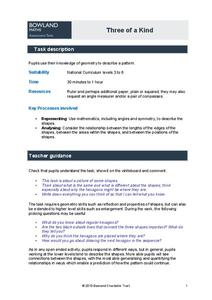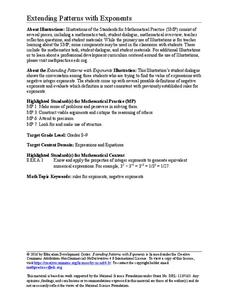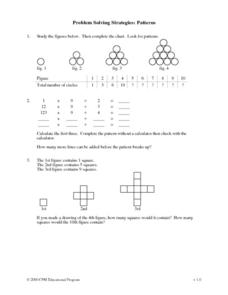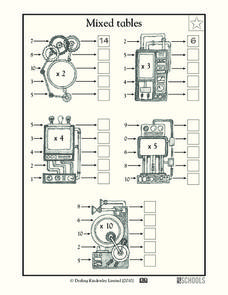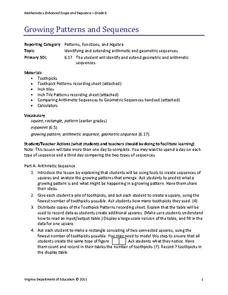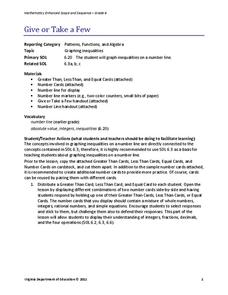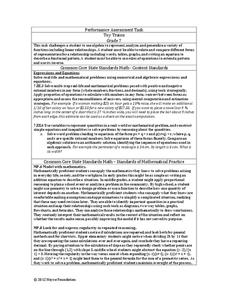Math in English
Number Patterns
Build the pattern recognition skills of young mathematicians with this simple skills practice worksheet. Given nine different sequences of two-digit numbers, children must identify the pattern and determine the next three numbers in...
Bowland
Three of a Kind
One is chance, two is a coincidence, three's a pattern. Scholars must determine similarities and differences of a regular hexagon undergoing dilation. They look at lengths, angles, areas, and symmetry.
Common Core Sheets
Determining Coordinates: Graphing Patterns
Building on their prior knowledge about patterns, this series of worksheets introduces young mathematicians to graphing in the coordinate plane. Using written descriptions of different numerical patterns, learners create sets of order...
Inside Mathematics
Two Solutions
Many problems in life have more than one possible solution, and the same is true for advanced mathematics. Scholars solve seven problems that all have at least two solutions. Then three higher-level thinking questions challenge them to...
Oregon Department of Education
Building Number Sense
It's never too early to begin a child's math education. This collection of fun hands-on activities engage youngsters in building their number sense as they learn how to count objects, identify numerals, compare amounts, and much more.
Curated OER
Extending Geometric Patterns
Which square comes next? Each of these sequences is made up of patterned squares in a continuing order. Learners examine more squares to choose which one(s) would correctly continue the pattern. None of these have very complex sequences;...
Education Development Center
Extending Patterns with Exponents
Don't think negatively about exponents. Young mathematicians dissect a fictional conversation between pupils trying to evaluate an expression with a negative exponent. This allows them to understand the meaning of negative exponents.
Curated OER
Problem Solving Strategies: Patterns
What's next in the series? Mathematicians study figures, graphs, and statements to determine what comes next in this patterns worksheet. They experiment with a multiplication chart and draw their own figures to continue specific...
Curated OER
Extending Patterns
For this mathematics worksheet, 1st graders draw the shapes that they see in the pattern illustrated. Then they identify which shape comes first, which comes after the circle, and which comes after the square. Students also draw the...
Curated OER
Extending Online Number Sequences
In this online number sequences worksheet, students work out the answers to eight comprehensive exercises with thirty-eight calculations involving a variety of sequences. Students answers are automatically graded online as they go and...
DK Publishing
Learning 1 - Write the Number
Begin your study of single-digit numbers with this activity on the number one. Young counters first trace and write the digit several times. Next, they practice counting by recording how many objects are in each image (always one)....
Curated OER
Odds and Evens
What happens when you multiply an odd number by an odd number? Scholars find out as they focus on patterns and number attributes while solving 48 multiplication problems. The first set has them multiply two odd numbers and record what...
Curated OER
Patterns
In this Algebra I worksheet, 9th graders explore number and geometric patterns and use the Sieve of Eratosthenes to find the prime numbers less than one hundred. The six page worksheet contains eight multipart questions. Answers are...
Curated OER
Insect Patterns
In this pattern worksheet, students look at the pattern of insect pictures in each of three rows. They draw the correct insect that will extend the pattern in the blank box at the end of each row.
Curated OER
Mixed Tables
These dinosaurs act like math machines as scholars practice their division skills. Each one has a given division function to apply to four incoming dividends. Pupils complete the equations, writing in the quotient for each. There are no...
Curated OER
Mixed Tables
Who knows how to operate these multiplication machines? Young mathematicians examine five machines, each with a specific function (i.e. x3) to transform the input numbers to output numbers. They send five numbers through each machine,...
Curated OER
Counting Forward or Back
What comes next? Young counters follow the stone path to each house, filling in numbers in a sequence as they go. Some of these move forward and some backward, but all progress by ones. Learners start with given numbers and then follow...
Curated OER
Problem Solving Strategy: Find a Pattern: Problem Solving
In this math patterns worksheet, students use the problem solving strategy of understand, plan, solve, and look back to help them find patterns to solve word problems.
Virginia Department of Education
Growing Patterns and Sequences
Learners explore, discover, compare, and contrast arithmetic and geometric sequences in this collaborative, hands-on activity. They build and analyze growing patterns to distinguish which kind of sequence is represented by a set of data...
Inside Mathematics
Conference Tables
Pupils analyze a pattern of conference tables to determine the number of tables needed and the number of people that can be seated for a given size. Individuals develop general formulas for the two growing number patterns and use them to...
Virginia Department of Education
Give or Take a Few
Young mathematicians extend their knowledge of rational numbers on a number line to graph inequalities by first using number cards to compare rational numbers. They finish by using similar reasoning to graph inequalities on a number line.
Curated OER
Challenge: Zero Patterns
In this multiplication worksheet, students use mental math to solve 12 multiplication problems. Students find the product of 1 or 2 digit numbers multiplied by 2 or 3 digit numbers. Students use the multiplication pattern of counting...
Curated OER
Problem-Solving Strategy: Find a Pattern: Problem Solving
In this finding patterns instructional activity, students use the problem solving strategy of understand, plan, solve, and look back to help them find the pattern in the swimming distances numbers. Students use the pattern to help them...
Noyce Foundation
Toy Trains
Scholars identify and continue the numerical pattern for the number of wheels on a train. Using the established pattern and its inverse, they determine whether a number of wheels is possible. Pupils finish by developing an algebraic...



